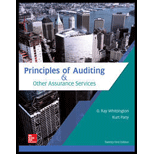
Principles Of Auditing & Other Assurance Services
21st Edition
ISBN: 9781259916984
Author: WHITTINGTON, Ray, Pany, Kurt
Publisher: Mcgraw-hill Education,
expand_more
expand_more
format_list_bulleted
Concept explainers
Question
Chapter 15, Problem 32COQ
To determine
Identify the appropriate answer related to the violation of the debt provisions.
Expert Solution & Answer
Want to see the full answer?
Check out a sample textbook solution
Students have asked these similar questions
Calculate the banks return on equity?
Financial Accounting Question
Tutor please provide answer
Chapter 15 Solutions
Principles Of Auditing & Other Assurance Services
Ch. 15 - What does the trust indenture used by a...Ch. 15 - Long-term creditors often insist upon placing...Ch. 15 - Prob. 3RQCh. 15 - Prob. 4RQCh. 15 - Prob. 5RQCh. 15 - Prob. 6RQCh. 15 - Prob. 7RQCh. 15 - Prob. 8RQCh. 15 - Prob. 9RQCh. 15 - Prob. 10RQ
Ch. 15 - Mansfield Corporation has outstanding an issue of...Ch. 15 - Prob. 12RQCh. 15 - Prob. 13RQCh. 15 - What do you consider to be the most important...Ch. 15 - What is the primary responsibility of an...Ch. 15 - In the audit of a small corporation that issues...Ch. 15 - Prob. 17RQCh. 15 - Prob. 18RQCh. 15 - Prob. 19RQCh. 15 - Corporations sometimes issue their own capital...Ch. 15 - Prob. 21RQCh. 15 - Prob. 22RQCh. 15 - Prob. 23RQCh. 15 - Prob. 24RQCh. 15 - Prob. 25RQCh. 15 - Prob. 26RQCh. 15 - Prob. 27QRACh. 15 - Prob. 28QRACh. 15 - Prob. 29QRACh. 15 - You are retained by Columbia Corporation to audit...Ch. 15 - Prob. 31QRACh. 15 - Prob. 32AOQCh. 15 - Prob. 32BOQCh. 15 - Prob. 32COQCh. 15 - Prob. 32DOQCh. 15 - Prob. 32EOQCh. 15 - When a client uses paper stock certificates, an...Ch. 15 - Prob. 32GOQCh. 15 - The auditors can best verify a clients bond...Ch. 15 - Prob. 32IOQCh. 15 - All corporate capital stock transactions should...Ch. 15 - Prob. 32KOQCh. 15 - Prob. 32LOQCh. 15 - Prob. 32MOQCh. 15 - Prob. 32NOQCh. 15 - Prob. 32OOQCh. 15 - An auditor most likely would inspect loan...Ch. 15 - Prob. 32QOQCh. 15 - Match the following definitions (or partial...Ch. 15 - Prob. 34PCh. 15 - Prob. 35PCh. 15 - Prob. 36PCh. 15 - Prob. 37P
Knowledge Booster
Learn more about
Need a deep-dive on the concept behind this application? Look no further. Learn more about this topic, accounting and related others by exploring similar questions and additional content below.Similar questions
- ??!!arrow_forwardA company purchased a cutting machine for $250,000. The machine has a useful life of 10 years and a residual value of $15,000. It is estimated that the machine could produce 100,000 units over its useful life. In the first year, 20,000 units were produced. In the second year, production increased to 25,000 units. Using the units-of-production method, what is the book value of the machine at the end of the second year?arrow_forwardKindly help me with this Financial accounting questions not use chart gpt please fast given solutionarrow_forward
- Financial Accountingarrow_forwardHayden Manufacturing computes its predetermined overhead rate annually on the basis of direct labor hours. At the beginning of the year, it was estimated that 40,000 direct labor hours would be required for the period's estimated level of production. The company also estimated $520,000 of fixed manufacturing overhead expenses for the coming period and variable manufacturing overhead of $4 per direct labor hour. Hayden's actual manufacturing overhead for the year was $684,000, and its actual total direct labor was 41,200 hours. Required: Compute the company's predetermined overhead rate for the year.arrow_forwardGeneral accounting question and right solutionarrow_forward
arrow_back_ios
SEE MORE QUESTIONS
arrow_forward_ios
Recommended textbooks for you
 Auditing: A Risk Based-Approach (MindTap Course L...AccountingISBN:9781337619455Author:Karla M Johnstone, Audrey A. Gramling, Larry E. RittenbergPublisher:Cengage Learning
Auditing: A Risk Based-Approach (MindTap Course L...AccountingISBN:9781337619455Author:Karla M Johnstone, Audrey A. Gramling, Larry E. RittenbergPublisher:Cengage Learning Auditing: A Risk Based-Approach to Conducting a Q...AccountingISBN:9781305080577Author:Karla M Johnstone, Audrey A. Gramling, Larry E. RittenbergPublisher:South-Western College Pub
Auditing: A Risk Based-Approach to Conducting a Q...AccountingISBN:9781305080577Author:Karla M Johnstone, Audrey A. Gramling, Larry E. RittenbergPublisher:South-Western College Pub- Business/Professional Ethics Directors/Executives...AccountingISBN:9781337485913Author:BROOKSPublisher:Cengage

Auditing: A Risk Based-Approach (MindTap Course L...
Accounting
ISBN:9781337619455
Author:Karla M Johnstone, Audrey A. Gramling, Larry E. Rittenberg
Publisher:Cengage Learning

Auditing: A Risk Based-Approach to Conducting a Q...
Accounting
ISBN:9781305080577
Author:Karla M Johnstone, Audrey A. Gramling, Larry E. Rittenberg
Publisher:South-Western College Pub


Business/Professional Ethics Directors/Executives...
Accounting
ISBN:9781337485913
Author:BROOKS
Publisher:Cengage